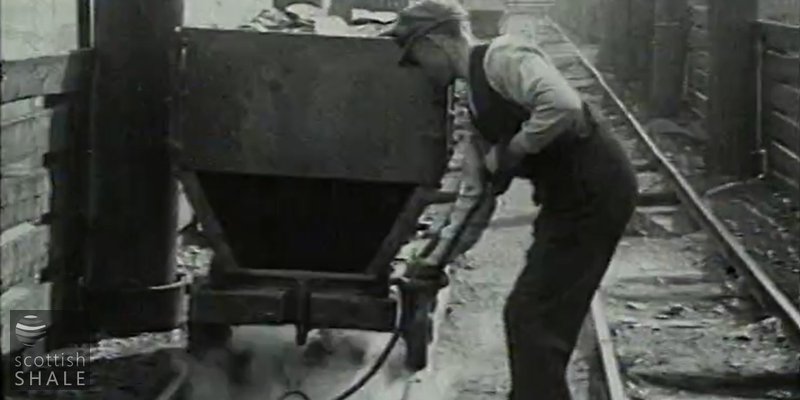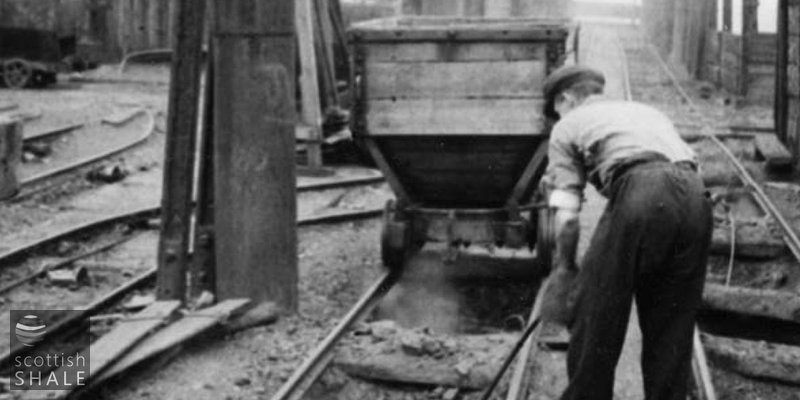Charger
also known as retort charger

See full record;

See full record; 198001
Oilshale was heated within a sealed retort to release crude oil from the mineral matrix. Fresh shale was periodically added to the top of the retort by chargers, and waste spent shale removed from the bottom by drawers or gulletmen.
Hopper hutches of shale were hauled up an inclined staging to the top centre of a bank of retorts, turned at right angles and pushed by the charger along the lines of rails on the top of each retort. Shale was discharged from the hutch after lifting the lid of the oval port on top of each retort.
Before becoming a charger, you might start as a general labourer at the oil works or be employed greasing the wheels of hutches prior to them being sent to the top of the retorts. You may then progress to "catching" empty hutches coming down from the retorts and attaching them together into a "rake" or train ready to be transported back to the mines. Snibbling was perhaps the next job you would be given, first on the ground then at the top of the retorts (a snibble was a bent steel rod with a ram's horn shaped handle that was used as a brake on the wheels of hutches) .
Wages & Working Hours
The Board of Trade Census of Wages conducted in 1886 records that chargers earned between 22s 9d and 27s 0d per week, the average being 24s 5d. The report states that men working in crude oil works worked a 13 day fortnight with the majority of chargers working between 54.5 and 63 hours per week.
No specifc data is available for chargers in the 1925 Report of a Court of Investigation Concerning the Wages Position in the Scottish Shale Oil Industry, however the average weekly wage for men employed in the crude oil works was £2 15s 3d. They worked an average of 6.67 days per week with many working 7 days per week.
By 1958, an Agreement Between the Scottish Shale Oil Companies and the National Union of Shale Miners & Oil Workers records that chargers earned 30s 8d per shift. As the retorts operated continuously, chargers received time and a half or double time for certain shifts on weekends. They worked 48 hours in shifts of 8 hours over 6 days per week.
"You had, four benches divided into half benches, and you had four halves on one side, so you had a rail going into the west side [the top half] and the east side [the bottom half] . The charger would come up, there was six of them on the day shift, three on the back shift, and you let go of the hutches and as he took the hutch away you tapped the point just like a railway". JD, Snibbler, Niddry Castle Oil Works, circa 1932
Top staging of shale retort, Deans Crude Oil Works, 1924
"In that half bench there were 16 retorts, there were 4 on each set, 8 sets and 4 in each set, which is 32, 16 each rail. You had a double rail, you may be away at the far end, well that was about 15 yards along or 20 yards, you lifted a bell off, it was on a hinge about 3 feet in diameter, with an iron on it and you put your cleek in with a hand and there was a right angle at the bottom for wheeling the shale out - there was a lever come to the ride of the hutch - the door was in the bottom and slots in the door, then you shoved this down, it opened the door up and the shale went into the retort. When you got that retort filled, you closed it up and we called it sanding, you get all the loose shale round about it to sand it to keep the air from getting in. Well you started that one you kept coming along filling them and bringing the hutch up". JD, Charger, Niddry Castle Oil Works, circa 1937-circa1959
"In the winter, it was terrible, when the snows were on and you always had two men with you, maybe three of us on the hutches instead of one and then of course they were frozen up - we had to hammer away. It was an awful wind from the west and you were in the bottom half of the retorts, or either half when you emptied it and you were trying to come out against that wind it was sheer murder trying to get out. There was 6 day shift men and 3 back shift men and I think the wage then was 9/7d, approximately. No holidays with pay and at the weekend all you got was for your Sunday shift, was an extra ½ shift, so you had 7 ½ shifts coming in. Nobody got paid holidays till after the war, coal miners were the first to get a week's paid holidays. So we got ½ shift for that and that was 10 ½ shifts a week. At New Year time you worked right through Christmas and New Year, at that time before you got holidays, until you got the 6 day week when you were off every 7th in the cycle. You got an extra half shift for the 1st and 2nd January". JD, Charger, Niddry Castle Oil Works, circa 1937
- Oral history transcript: Mr J Docherty
- Oral history transcript: Mr William Getty (Winchburgh)